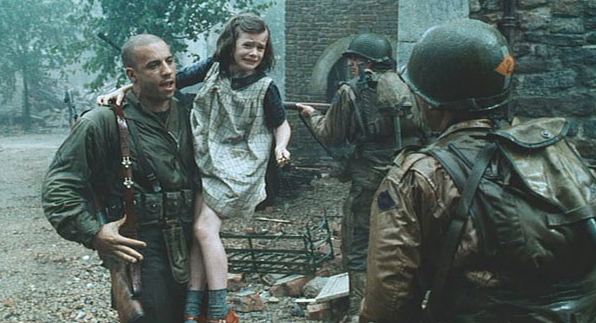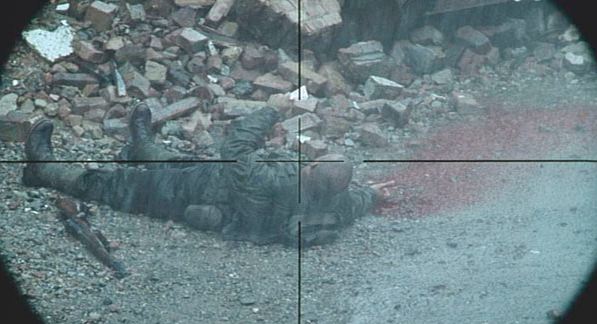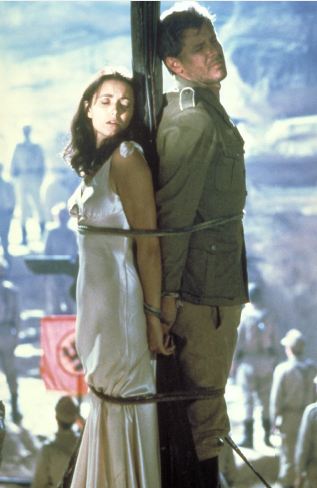Saving Private Ryan screenplay

I’ve been using Robert Rodat’s Saving Private Ryan screenplay for years as a case study for my writers and I cite it a number of times in my book Story Maps: How to Write a GREAT Screenplay. The structure is rock-solid, the story is active and Rodat’s voice on the page is commanding. Here’s one of my favorite introductions of a Protagonist…
[scrippet]
A YOUNG SOLDIER
His face covered with the remains of the motorman. Starts to lose it. Begins to shudder and weep. His name is DELANCEY.
THE BOYS AROUND HIM
Do their best to stare straight ahead. But the fear infects them. It starts to spread.
A FIGURE
Pushes through the men. Puts himself in front of DeLancey.
The figure is CAPTAIN JOHN MILLER. Early thirties. By far the oldest man on the craft. Relaxed, battle-hardened, powerful, ignoring the hell around them. He smiles, puts a cigar in his mouth, strikes a match on the front of DeLancey’s helmet and lights the cigar.[/scrippet]
Although it’s a long film and the page points differ from the traditional Story Map beat sheet, the signpost beats are perfectly in line with the characteristics I define in the book. For example, the First Trial/First Casualty beat that normally falls in the page 38-40 range is defined as the first skirmish on the new path that our Protagonist has chosen for Act Two, foreshadowing a larger battle and reinforcing that there is no going back. There must be some kind of failure that leads to a consequence, or, “casualty.”
In this case, as in many war films, the casualty is literal–a member of the platoon (Vin Diesel) is killed in a firefight, directly as a result of disobeying orders for moral reasons–he brings a little girl to safety and forgets about himself for just a second. He’s shot by a sniper.
This echoes the strongest theme in the film: the consequences of sacrifice. Who or what is worth the sacrifice of your own life? In war, there’s never a clear answer, and this ambiguity can lower morale, which makes the job of the commanding officer that much more difficult. Captain Miller (Tom Hanks) is continuously forced to make the choice of how to protect his men while serving the mission, even when those two goals are at odds.
This brings me to why I wanted to mention this Steven Spielberg movie once again. In a recent discussion thread on Scriptshadow, a commenter questioned Captain Miller’s decision at the end of Act Two to remain with Private Ryan (Matt Damon) and hold the bridge with his men. This commenter didn’t feel it was realistic or motivated, after all that Miller and his platoon had been through, but I couldn’t disagree more. Here’s what I wrote…
It has to do with sacrifice.
We see a platoon of jaded veterans forced on a mission by their Captain, and the longer they go on the journey and as their friends die, the more frustrated and cynical they get, including the Captain. They just want to get this spoiled kid James Ryan and get the hell home to their families. Screw honor, flag, country and mission.
When they finally find Ryan, he won’t leave because he’s sworn to stand with his own platoon and hold the bridge. If they don’t hold the bridge, other American soldiers will die; strangers to them, but still, fellow American soldiers.
The Captain has a brutal choice to make — risk the lives of his men yet again to save more men they don’t know, or cut and run on this foolhardy mission and report back to command that the stupid kid wouldn’t go with them.
Captain Miller not only decides to stand and fight, but he formulates a plan to take out the German tanks, thrusting them and us into Act Three.
In the end, Miller makes the final sacrifice — he GIVES HIS LIFE in the battle, and in that moment, we see Private Ryan morph into the old man in the cemetery in the present day and we realize why the old man asked his wife if he was a good man, if his life “was worth it.” Because this group of strangers, led by this brave officer, gave their lives for his, and the Captain’s last words to him were “earn this.”
Ultimately, I admit that the film has its flaws — it’s manipulative and some scenes drag on too long — but the overall achievement is a great one and the story is a nice case study for writing in any genre.
Good Luck and Happy Writing,
Dan
P.S. If you get the book, you’ll also learn the significance of Tom Sizemore in Saving Private Ryan filling up the cans of shoe polish with dirt from Omaha Beach. Now that you know this, can you afford to NOT read this book?!





Saving Private Ryan is an awesome screenplay. But, that draft floating around the net is way, way ancient. There was a lot of directorial vision incorporated into the script in subsequent drafts, as you may realize, a sample of which is revealed in a certain ‘ Saving Private Ryan- Memo’. I do not think the final version as seen on the screen is manipulative at all.
And, about why he decided to stay and fight the battle as opposed to pack up and go home, the first reason that popped into my head is that -- You never foreshadow an impending battle sequence and not show it. 🙂
Dan,
Can you recommend screenwriting software — Final Draft? Celtx? etc.
Thanks, Paul
Hi Paul,
personally I prefer Final Draft and I may actually be able to get you a discount rate on it so shoot me an email via one of the contact forms on my site. 🙂
Celtx is the best option if you want a no-frills, FREE script format program to get your feet wet, but you’ll probably want to graduate to Final Draft at some point. Some people also prefer Movie Magic Screenwriter and I aim to try it out at some point but haven’t got around to it. 🙂